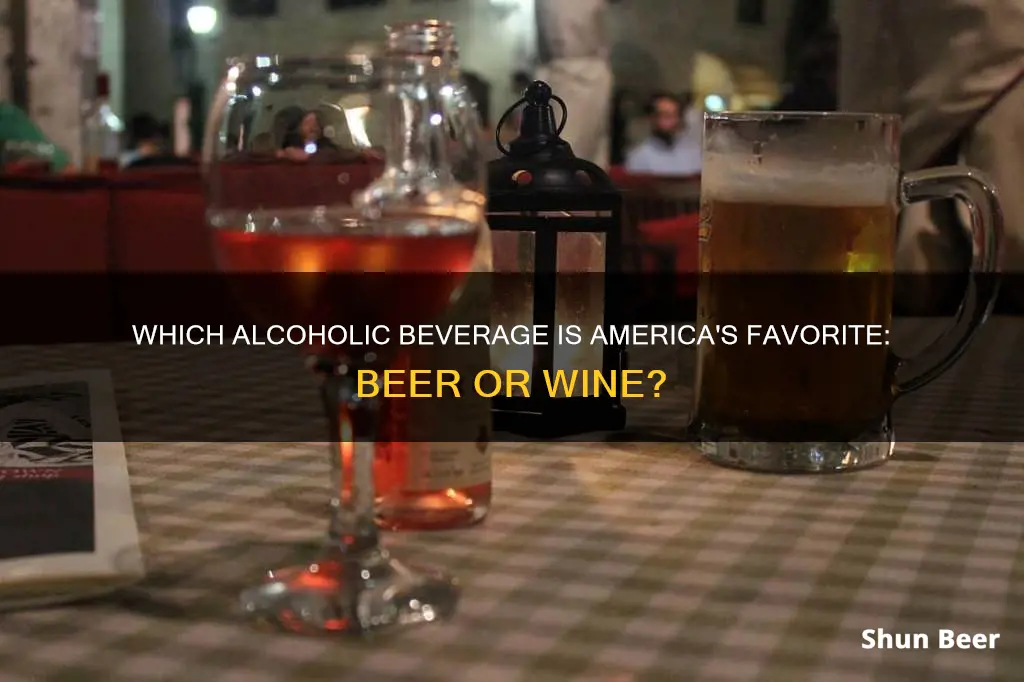
Beer and wine are two of the most commonly consumed alcoholic drinks worldwide. In the US, beer is the most frequently consumed alcoholic beverage, with 37% of respondents in a Gallup survey saying they drink it most often. However, wine is a close second, with 29% of respondents saying it was their drink of choice. Globally, China is the largest producer and consumer of beer, while the US is the largest consumer of wine.
What You'll Learn
- Beer is the most frequently consumed alcoholic drink in the US, with 37% of respondents to a Gallup survey saying they drink it most often
- In the US, 62% of adults say they drink alcohol, while 38% abstain completely
- In 2017, the US consumed an estimated 65 billion 12 oz. beers and over 4 billion bottles of wine
- In 2021, the average American aged 21 or older consumed 2.83 gallons of pure alcohol, or about 603 standard drinks
- Beer consumption has decreased in the US since 1981, when the typical American aged 21 or older drank 36.7 gallons

Beer is the most frequently consumed alcoholic drink in the US, with 37% of respondents to a Gallup survey saying they drink it most often
Gallup surveyed 1,015 adults in all 50 states and Washington, D.C., and found that 62% of respondents drank alcohol, with the majority (69%) having had at least one alcoholic drink in the past week. This is close to the 63% average that dates back to 1939, when Gallup first started asking this question. The lowest percentage of drinkers was in 1958 (55%), and the highest was in the late 1970s (71%).
There were some demographic differences in the survey results: men were more than twice as likely as women to say they drank beer most frequently (53% vs 22%), while women were around three times as likely as men to opt for wine (44% vs 15%). The youngest age group (18-34) reported drinking beer and liquor more frequently than the other two age groups, while the older demographics chose wine almost twice as often as their younger counterparts.
Beer is also "less dominant" as a drink choice than it was in the early 2000s, while liquor has gained in popularity. Thirty-one per cent of drinkers now say that some kind of liquor is "their favourite alcoholic drink", which is the highest percentage Gallup has ever recorded.
In terms of overall alcohol consumption in the US, 60% of adults drank alcoholic beverages in 2021, which decreased from 65% in 2019. The average number of drinks consumed in the previous seven days also decreased during this period, from 4.0 drinks to 3.6 drinks.
When it comes to alcoholic beverage preferences, data from the Wine Market Council / NielsenIQ's 2022 Wine & Spirits Daily Summit revealed that while most consumers drank from more than one category, 14% drank spirits only, and 11% drank other beverages such as cider and hard seltzers.
Liver Biopsy: Drinking Beer, Safe or Not?
You may want to see also

In the US, 62% of adults say they drink alcohol, while 38% abstain completely
The demographic groups most likely to report drinking alcohol are those who are middle-aged (between 35 and 54), have household incomes of $100,000 or more, are college-educated, and attend religious services less than once a week.
The most common reasons given by adults who don't drink alcohol are that they simply have no desire to (24%), they don't like the taste (16%), they believe it's unhealthy (14%), they're afraid of the consequences (13%), or they've had a bad experience with alcohol in the past (13%).
Among those who do drink, the majority (69%) had had at least one alcoholic drink within the past week, with 32% having had a drink within 24 hours of the survey and 37% within the past two to seven days.
Beer is the most frequently consumed alcoholic drink in the US, with 37% of respondents saying they drink it "most often", followed by liquor (31%) and wine (29%). Men are more than twice as likely as women to say they drink beer most frequently (53% vs 22%), while women are around three times as likely as men to say they drink wine more often (44% vs 15%).
The average number of drinks consumed in the previous seven days has decreased over time. In 2019, consumers aged 18 and older drank an average of 4 drinks in a seven-day period, but in 2021 that average had dropped to 3.6 drinks.
How Warm Beer Became a Historical Quirk
You may want to see also

In 2017, the US consumed an estimated 65 billion 12 oz. beers and over 4 billion bottles of wine
Beer and wine are two of the most commonly consumed alcoholic beverages worldwide. In the United States alone, an estimated 65 billion 12 oz. beers were consumed in 2017, along with over 4 billion bottles of wine. This massive consumption rate raises questions about alcohol abuse and its correlation with production and consumption levels.
The United States is a top consumer of both beer and wine globally. In 2017, Americans drank approximately 65 billion 12 oz. beers, making the country the second-largest consumer after China. The US beer industry is robust, with a high domestic production rate of 79% in 2023 and an extensive network of breweries. The US also has a strong preference for packaged beer, with aluminium cans and glass bottles accounting for 91% of beer sales in 2023.
Wine consumption in the US is also noteworthy, with Americans drinking over 4 billion bottles in 2017. This makes the US the largest consumer of wine in the world, outpacing France and Italy. California's wine industry is particularly prominent, crushing 4 million tons of wine grapes annually. However, wine sales have faced challenges due to younger Americans' preference for hard seltzers and premium spirits, as well as high prices, especially in restaurants.
While the US has a significant beer and wine consumption, it's important to consider the broader context of alcohol consumption in the country. According to Gallup, 62% of US adults consume alcohol, with adults aged 35 to 54, college-educated individuals, and those with higher incomes being more likely to drink. Additionally, per-capita alcohol consumption has been gradually increasing, with the average American aged 21 or older consuming 2.83 gallons of pure alcohol in 2021.
In conclusion, the US consumed an estimated 65 billion 12 oz. beers and over 4 billion bottles of wine in 2017, reflecting the country's high consumption rates of these beverages. However, it's important to consider alcohol consumption patterns, production levels, and social factors to understand the broader landscape of alcohol usage in the United States.
Non-Alcoholic Beer: A Safe Drink for Crohn's Sufferers?
You may want to see also

In 2021, the average American aged 21 or older consumed 2.83 gallons of pure alcohol, or about 603 standard drinks
In 2021, the average American aged 21 or older consumed 2.83 gallons of pure alcohol, which is equivalent to about 603 standard drinks. This number is calculated by the National Institute on Alcohol Abuse and Alcoholism (NIAAA) and represents a significant increase from the previous year's consumption levels. The NIAAA has been tracking alcohol consumption data since 1970, providing valuable insights into long-term trends.
The 2.83 gallons of alcohol consumption translates into approximately 603 standard drinks, as defined by the NIAAA. This amount reflects a notable rise in alcohol consumption among Americans over the age of 21. It is worth noting that a standard drink contains 0.6 ounces of alcohol, as per the NIAAA's definition.
While alcohol consumption has generally increased, there have been shifts in the types of alcoholic beverages Americans prefer. Since 1970, Americans have been drinking less beer and more wine. Specifically, beer consumption peaked in 1981 when the average American aged 21 or older drank 36.7 gallons. By 2021, this number had dropped to 26.5 gallons per person. On the other hand, wine consumption has been on the rise, with the average American's annual wine intake increasing from 3.2 gallons in 1970 to 3.8 gallons in 2021.
These changes in drinking preferences have resulted in shifts in the market share for different types of alcoholic beverages. In 2021, wine accounted for 17.4% of all alcohol consumed by Americans, a significant increase from 12.0% in 1971. During the same period, the share of beer consumption decreased from 44.6% to 42.3%, while the share of distilled spirits fell slightly from 43.5% to 40.3%. These numbers indicate that while beer remains the most consumed alcoholic beverage, wine is gaining popularity, and spirits hold a relatively stable position in the market.
It is worth noting that alcohol consumption patterns vary across different demographic groups. According to Gallup, men are more likely to consume alcoholic beverages than women, with 63% of men and 57% of women drinking alcohol. Additionally, adults aged 35 to 54 have a higher drinking prevalence than younger and older adults. Income and education levels also play a role, with higher-income and college-educated individuals being more likely to consume alcohol.
Beer and Lomotil: Is It Safe to Mix?
You may want to see also

Beer consumption has decreased in the US since 1981, when the typical American aged 21 or older drank 36.7 gallons
Beer consumption in the US has been on a downward trajectory since 1981, when the average American aged 21 or older drank 36.7 gallons of beer. This decline is part of a broader shift in American drinking preferences, with consumers increasingly opting for wine and spirits over beer.
A Historical Perspective
Beer has a long history in the US, dating back to the early communities established by English and Dutch settlers in the 17th century. Dutch immigrants, recognising the suitability of the climate and terrain in present-day New York for brewing, established breweries and taverns, with a 1660 map of New Amsterdam detailing 26 such establishments. Despite this early popularity, other alcoholic beverages gained prominence by the early 18th century.
The Rise of Beer
The period between 1865 and 1920 marked a significant shift, with beer emerging as the nation's dominant alcoholic drink. This transformation was driven by various factors:
- Immigration from beer-drinking countries like Britain, Ireland, and Germany.
- Industrialisation and urbanisation, leading to a growing population of workers who drank beer.
- Increased wages, enabling more people to purchase beer.
- The temperance movement, which advocated for lower-alcohol beer over spirits.
- Technological advancements, such as artificial refrigeration and pasteurisation, that improved beer production and shelf life.
- The introduction of lager beer, which gained popularity among German immigrants.
Post-Prohibition Era
Following Prohibition, which significantly disrupted the beer industry, the 1945-1980 period witnessed a rebound in beer production and consumption. However, this growth was slower than the overall population increase.
Recent Trends
Since 1980, beer production has continued to rise, reaching nearly 200 million barrels in 2000. Notably, per capita consumption peaked in 1981 at 23.8 gallons and has since declined. This shift is attributed to changing consumer preferences towards premium options, imported beers, and the emergence of craft beers.
Ibuprofen and Beer: Is It Safe to Mix?
You may want to see also
Frequently asked questions
Beer consumption has been decreasing since its peak in 1981. In 2021, the average American consumed 26.5 gallons of beer per year, down from 36.7 gallons in 1981.
Since 1970, the amount of wine consumed by the average American has increased. In 2021, the average American consumed 3.8 gallons of wine per year, up from 3.2 gallons in 1970.
According to a 2023 Gallup survey, 37% of respondents said they drank beer the most often, followed by liquor (31%) and wine (29%). However, another survey in 2022 showed that beer was only slightly more popular than wine, with 35% and 31% respectively.
Men are more than twice as likely as women to say they drink beer the most often (53% vs 22%), while women are around three times as likely as men to say they drink wine the most often (44% vs 15%).







